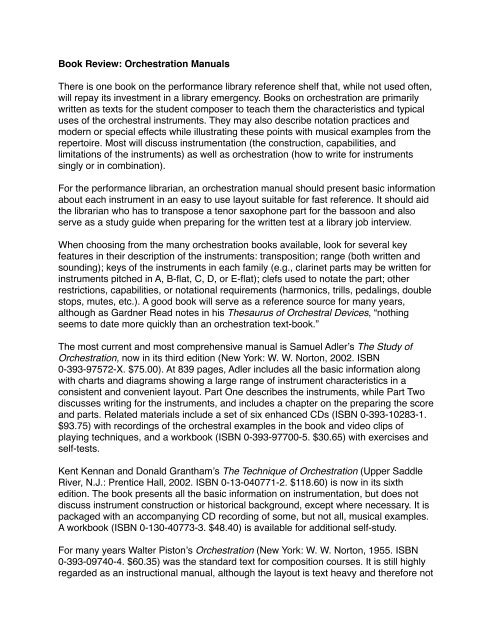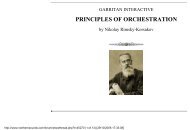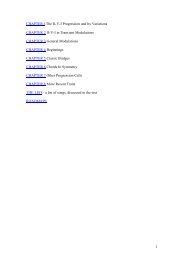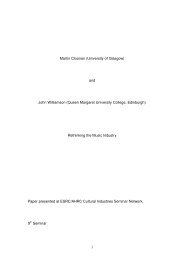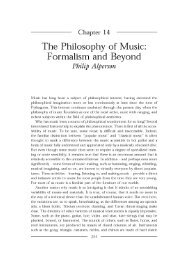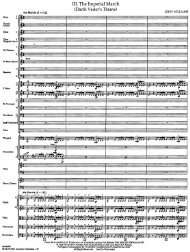Orchestration Manuals - Synapse Music
Orchestration Manuals - Synapse Music
Orchestration Manuals - Synapse Music
You also want an ePaper? Increase the reach of your titles
YUMPU automatically turns print PDFs into web optimized ePapers that Google loves.
Book Review: <strong>Orchestration</strong> <strong>Manuals</strong><br />
There is one book on the performance library reference shelf that, while not used often,<br />
will repay its investment in a library emergency. Books on orchestration are primarily<br />
written as texts for the student composer to teach them the characteristics and typical<br />
uses of the orchestral instruments. They may also describe notation practices and<br />
modern or special effects while illustrating these points with musical examples from the<br />
repertoire. Most will discuss instrumentation (the construction, capabilities, and<br />
limitations of the instruments) as well as orchestration (how to write for instruments<br />
singly or in combination).<br />
For the performance librarian, an orchestration manual should present basic information<br />
about each instrument in an easy to use layout suitable for fast reference. It should aid<br />
the librarian who has to transpose a tenor saxophone part for the bassoon and also<br />
serve as a study guide when preparing for the written test at a library job interview.<br />
When choosing from the many orchestration books available, look for several key<br />
features in their description of the instruments: transposition; range (both written and<br />
sounding); keys of the instruments in each family (e.g., clarinet parts may be written for<br />
instruments pitched in A, B-flat, C, D, or E-flat); clefs used to notate the part; other<br />
restrictions, capabilities, or notational requirements (harmonics, trills, pedalings, double<br />
stops, mutes, etc.). A good book will serve as a reference source for many years,<br />
although as Gardner Read notes in his Thesaurus of Orchestral Devices, “nothing<br />
seems to date more quickly than an orchestration text-book.”<br />
The most current and most comprehensive manual is Samuel Adlerʼs The Study of<br />
<strong>Orchestration</strong>, now in its third edition (New York: W. W. Norton, 2002. ISBN<br />
0-393-97572-X. $75.00). At 839 pages, Adler includes all the basic information along<br />
with charts and diagrams showing a large range of instrument characteristics in a<br />
consistent and convenient layout. Part One describes the instruments, while Part Two<br />
discusses writing for the instruments, and includes a chapter on the preparing the score<br />
and parts. Related materials include a set of six enhanced CDs (ISBN 0-393-10283-1.<br />
$93.75) with recordings of the orchestral examples in the book and video clips of<br />
playing techniques, and a workbook (ISBN 0-393-97700-5. $30.65) with exercises and<br />
self-tests.<br />
Kent Kennan and Donald Granthamʼs The Technique of <strong>Orchestration</strong> (Upper Saddle<br />
River, N.J.: Prentice Hall, 2002. ISBN 0-13-040771-2. $118.60) is now in its sixth<br />
edition. The book presents all the basic information on instrumentation, but does not<br />
discuss instrument construction or historical background, except where necessary. It is<br />
packaged with an accompanying CD recording of some, but not all, musical examples.<br />
A workbook (ISBN 0-130-40773-3. $48.40) is available for additional self-study.<br />
For many years Walter Pistonʼs <strong>Orchestration</strong> (New York: W. W. Norton, 1955. ISBN<br />
0-393-09740-4. $60.35) was the standard text for composition courses. It is still highly<br />
regarded as an instructional manual, although the layout is text heavy and therefore not
as convenient for quick reference. Because it has not been updated in many years, it is<br />
starting to show its age. In the chapter on percussion, for example, the most recent<br />
musical example is from the Bartók Concerto for Orchestra (1945) and the only<br />
electronic instrument included is the Ondes Martenot which is “still in an early<br />
experimental stage.”<br />
The Handbook of Instrumentation by Andrew Stiller (Philadelphia: Kallisti <strong>Music</strong> Press,<br />
2nd edition 1994. ISBN 0-9645431-0-2 [cloth]; for sale in paperback [$69.00] or CD-<br />
ROM [$39.95] from www.npcimaging.com) focuses solely on instrumentation. It includes<br />
detailed line drawings of the instruments with many accompanying tables and charts.<br />
Stiller discusses the instrument characteristics in such depth (including fingering charts)<br />
that this book would also be a valuable aid to a school music teacher. He restricts<br />
coverage to instruments used in contemporary classical and popular music in North<br />
America, but does include a wide variety of percussion instruments (over 130 pages),<br />
keyboard, and electronic instruments, and devotes three chapters to early instruments<br />
used in modern recreation performances (psalteries, lyres, lutes, etc.). The book is<br />
lacking in musical examples from the repertoire (probably due to to the cost of<br />
permissions to reproduce such excerpts), but there are many lists for suggested<br />
listening.<br />
Alfred Blatterʼs Instrumentation/<strong>Orchestration</strong> (New York: Schirmer Books/Cengage<br />
Learning, 2nd edition revised 1997. ISBN 0-534-25187-0. $90.95) is intended for<br />
beginning or intermediate orchestration students. It has all the necessary information for<br />
a handy reference book, and it begins with a chapter on “Preparing Scores and Parts”—<br />
a fine introduction for the student composer.<br />
Although not intended as an orchestration manual, Anatomy of the Orchestra by<br />
Norman Del Mar (Berkeley, Los Angeles: University of California Press, 1983. ISBN<br />
0-520-05062-2. $33.95) contains basic information about the instruments (range,<br />
transposition, etc.), although it is often set inside paragraphs of text. Its strength is in the<br />
descriptions of how the instruments are used in the orchestral repertoire, both in typical<br />
and extended techniques. It is more useful for its educational value than as a ready<br />
reference source.<br />
Alfred Publishing has a volume in their pocket dictionary series that contains basic<br />
instrumental information. The Essential Dictionary of <strong>Orchestration</strong> by Dave Black and<br />
Tom Gerou (Los Angeles: Alfred Publishing, 2nd edition 1998. ISBN 0-7390-0021-7.<br />
$6.95) is a convenient, portable handbook with an easy to read format. Unfortunately<br />
the instruments are arranged alphabetically within their class and family (clarinets, then<br />
double reeds, then flutes, etc.) rather than by score order or range, as most other<br />
manuals are arranged, and this works against the convenience of this book.<br />
Classic <strong>Manuals</strong>. The value of early orchestration books to the performance librarian is<br />
for information about instruments that appear in period compositions but are no longer<br />
in common use, such as sarrusophones, ophicleides, serpents, and even the Russian<br />
bassoon. Parts for these instruments still appear in standard repertoire works (such as
the Contralto trumpet in F in the Shostakovich Symphony No. 1 or the orchestral<br />
saxophones in Symphonia Domestica) and, consequently, on library interview tests.<br />
One of the earliest orchestration manuals is Berliozʼs Grand traité dʼinstrumentation et<br />
dʼorchestration modernes, originally published in 1843. A modern edition, edited by<br />
Peter Bloom, is published as volume 24 in the New Edition of the Complete Works of<br />
Berlioz (Kassel, New York: Bärenreiter, 2003. ISBN 978-3-7618-1586-1. €310.00). This<br />
is the first entirely new publication in French since the 1843 edition. An English<br />
translation by Hugh Macdonald is published as Berliozʼs <strong>Orchestration</strong> Treatise: A<br />
Translation and Commentary (Cambridge, New York: Cambridge University Press,<br />
2002. ISBN 978-0-5212-3953-2. $74.00) and includes excerpts from Berliozʼs other<br />
writings in addition to Macdonaldʼs annotations.<br />
Richard Strauss revised and enlarged the Berioz treatise and published it in German in<br />
1905. This was translated into English by Theodore Front and published as Treatise on<br />
Instrumentation (New York: Kalmus, 1948; reprint: Mineola, N.Y.: Dover Publications,<br />
1991. ISBN 0-486-26903-5. $26.95). Straussʼs comments appear in the text identified<br />
by a wavy line in the left margin. He also updated many of the musical examples,<br />
adding a number of Wagner excerpts. The original Kalmus version of this book has<br />
been scanned and is available in pdf format at the International <strong>Music</strong> Score Library<br />
Project .<br />
Another early classic is Cecil Forsythʼs <strong>Orchestration</strong>, originally published in 1914 with a<br />
second edition in 1935, currently reprinted by Dover (New York: Dover Publications,<br />
1982. ISBN 0-486-24383-4. $19.95). Forsythʼs book includes 530 pages, 296 repertoire<br />
examples, numerous range, transposition, and characteristic charts, with descriptions of<br />
the contemporary band and orchestral instruments. It is an excellent value for the library<br />
bookshelf.<br />
<strong>Orchestration</strong> in Other Styles. There are also specific orchestration books for film and<br />
jazz composition. They present techniques for writing in that style, but because they<br />
typically donʼt include specifics about the individual instruments these are less valuable<br />
as a reference source for the performance library. Books about writing for film include<br />
Earle Hagenʼs Advanced Techniques for Film Scoring (Los Angeles: Alfred Publishing,<br />
1990. ISBN 0-8828-4447-4. $39.95), which is an update of his 1971 book Scoring for<br />
Films. This manual is a bit dated, considering the recent rapid advances in computeraided<br />
scoring and digital recording techniques. A more comprehensive guide is On the<br />
Track: A Guide to Contemporary Film Scoring by Fred Karlin (New York: Routledge, 2nd<br />
edition 2004. ISBN 0-4159-4136-9. $70.00).<br />
Some of the jazz manuals are interesting for their explanation of how to write in the<br />
unique style of the author. These include Arranged by Nelson Riddle: The Definitive<br />
Study of Arranging by Americaʼs #1 Composer, Arranger and Conductor by Nelson<br />
Riddle (Miami: Warner Bros., 1985. ISBN 0-8989-8667-2. $29.95), Sounds and Scores:<br />
A Practical Guide to Professional <strong>Orchestration</strong> by Henry Mancini (Los Angeles: Alfred
Publishing, 1999. ISBN 0-8989-8667-2. $49.95), The Complete Arranger by Sammy<br />
Nestico (s.l.: Fernwood <strong>Music</strong>, 1993; distributed by Kendor <strong>Music</strong>. $49.95), The<br />
Contemporary Arranger: Definitive Edition by Don Sebesky (Van Nuys, Calif.: Alfred<br />
Publishing, 1984. ISBN 0-8828-4485-7. $49.95), Jazz Composition and <strong>Orchestration</strong><br />
by William Russo (Chicago: University of Chicago Press, 1968. ISBN 0-2267-3208-8.<br />
Out of print), and even Glenn Millerʼs Method for Orchestral Arranging (New York:<br />
Mutual <strong>Music</strong> Society, 1943. Out of print).<br />
Extra-Curricular Materials. No one has written more on orchestration practice than<br />
Gardner Read. His Style and <strong>Orchestration</strong> (New York: Schirmer Books, 1979. ISBN<br />
0-02-872110-1. Out of print) is a historical survey of the technique and performance<br />
practice in the orchestral repertoire from the 1800s to the 20th century. In 1953 Read<br />
published the Thesaurus of Orchestral Devices (reprint: Westport, Conn.: Greenwood<br />
Publishing, 1969. ISBN 0-8371-1884-0. $65.00), a catalog of musical effects and the<br />
compositions that use those effects. He identifies the use of extreme and extended<br />
ranges, harmonics, mutes, off-stage use, and many other characteristics in the<br />
repertoire. This catalog was continued in two later books: Contemporary Instrumental<br />
Techniques (1976) which was revised as Compendium of Modern Instrumental<br />
Techniques (Westport, Conn.: Greenwood Press, 1993. ISBN 0-313-28512-8. $88.95),<br />
and Orchestral Combinations: The Science and Art of Instrumental Tone-Color<br />
(Lanham, Md.: Scarecrow Press, 2004, ISBN 0-810-94814-7. $53.60).<br />
For more writings on the art and practice of orchestration, James E. Perone has<br />
compiled an extensive list of books, monographs, and articles in his <strong>Orchestration</strong><br />
Theory: A Bibliography (Westport, Conn.: Greenwood Press, 1996. ISBN<br />
0-313-29596-4. $98.95). Writings on orchestration from composers including Berlioz,<br />
Wagner, Stravinsky, Mahler, and others are collected in <strong>Orchestration</strong>: An Anthology of<br />
Writings, edited by Paul Mathews (New York: Routledge, 2006. ISBN 0-415-97683-1.<br />
$36.95). For the background of orchestral practice, Adam Carse wrote the standard<br />
guide in The History of <strong>Orchestration</strong>, originally published in 1925 (unabridged and<br />
corrected reprint edition: New York: Dover Publications, 1964. Currently out of print, but<br />
with limited access on Google Books at http://books.google.com).


